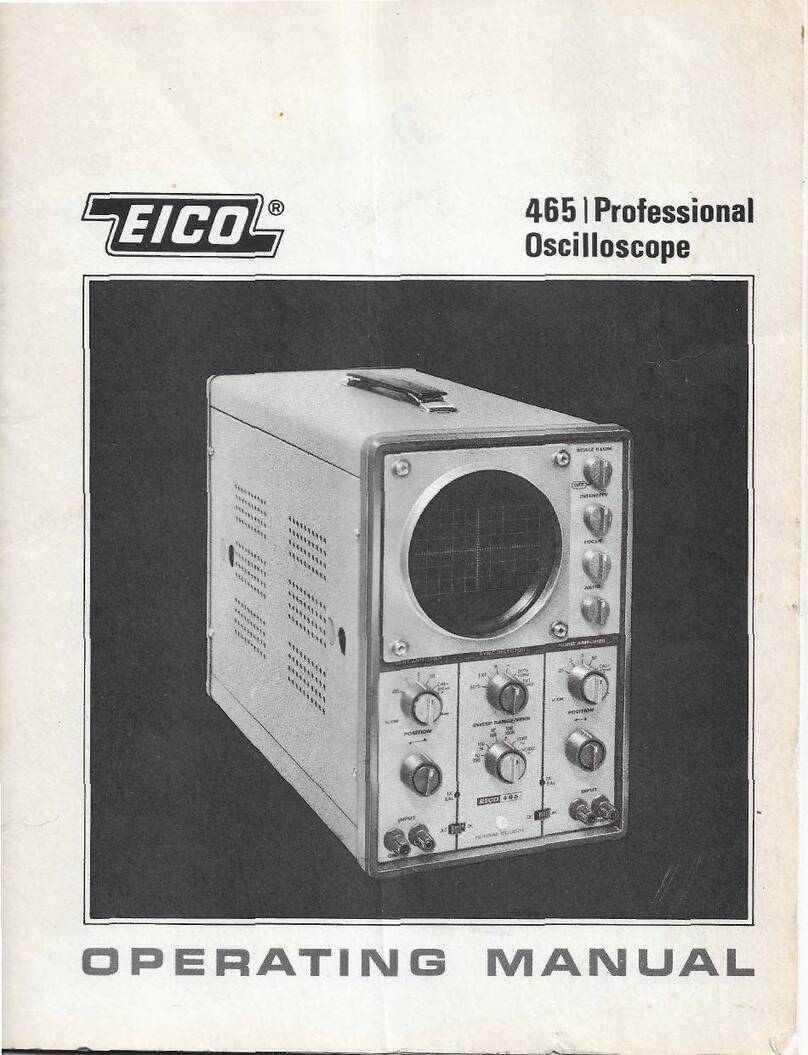
'), 1{"lal tho RANGEselector to the position which gives a reading nearest"
full scele and read the ac voltage.
NOTE: All RMSscales are inblack with full-scale values of 1
,:~:,:5·,
i5,5()~'
500, and 1500 volts. All peak-to-peakscales are in.red with full;.s:Cah~.;"alue$ .'.
4,14,42,140,420, 1400, and 4200 volts. When the instrument
is
se.t at the
1.5 vo It range, the RMS or P-P sca Ies on the lowest arc (deslqricted as LOW-~
AC) are read; on higher ranges, the scales on the two center arcs are
reed.
Itshould be noted that the fixed ratio of 2.83 to 1between corresponding peck-
to-peak and rms scales is derived from the relationship between the peak-
to-peak and rms values of a sine wave. There fore, while peek-to-peck read-
ings are valid regardless of whether the waveform is complex or sine, rmsread-
irigs are valid only for sine waves. Note also that the time delay between the
instant the leads are removed from the source being measured and the Instcnt
the meter pointer returns to zero is normal and is the result of ci~cuit constants
sel·ected to permit accurate measurement of recurrent pulses with low repefl-
tion rates. '
applications
This instrument may be used fo maintain and service television receivers,
frn-om and communication receivers, transmitters, audio equipment, and pul-
sed electronic and electro-mechanical equipment. Indicative of itsversatllity
are some of the special applications described below.
9;?CJLLATQR
SiRlIrQJ~_./fI.f;.~~.V.BfMr.~T:
Tho negative dc voltage devel-
rId
II
alway. directly proportional to the strength' of
1111
1lllIthm. rltl_
voltago can be measured very readily at the oscillator grid
willi., tit" lxmd
.wltch Is turned to the various bands, and in each of its posi-
tions the main tuning condenser is rotated from minimum capacity. This wi·11
give an indication of the strength of oscillation at all frequencies within. fhe
oscillator's range.
AVC-VOLTAGE MEASUREMENTS: The automatic volume control voltage de-
veloped by the fncomlng signal can be measured at a number of places, in the,
receiver. This negative voltage first appears across the diode load resistor. It,
may also be measured along the avc bus and at the grids of the rftubes being,
controlled, The dc voltage measured at the diode load resistor Is a very con-
venient output indication during receiver alignment.
Owing to the high input resistance of this instrument, it is p,ossible to meas-
ure bias (avc)voltage on the grid of rf and if amplifier tubes without disrupting
the signal. '
DC SUPPLY VOLTAGE MEASUREMENTS: Power supply dc voltages can be
·6·
',",
,t·~
5' •..
.
~
~-
:.:. -=::::::::.:7....:.
',1 ;~~
';, measured at the rectifier filaments and in the filter circuits. Plate, screen,
and cathode dc voltages can be measured at the corresponding pins of the tube
sockets ..
BIASCEL~:VOLTAGE MEASUREMENTS: This instrument wiIIaccurately meas-
ure the,vortag'e of a bios cell. Current drawing voltmeters are not capable
'bf making this' measurement and in many cases wiII damage the cell.
'f
1
.~j DETECTION OF GASSY TUBES: One effect of a gassy tube is to reduce the
normal negative gri,d bios, or even make the grid positive. This instrument is
ideal for measuring the voltage directly at the control grid of any tube in
.<'.
order to determine whether or not this effect is present. Excessive gas will
, couse the tube to cease operating normally, and in an audio amplifier will
uSlJOllycause the volume control to become noisy. This amount of gas will
not always produce a noticeable change in the operation of the radio receiver.
J
, Consequently if repeated difficulty is experienced with volume controls be-
.~ . coming nolsy in this type of circuit, this instrument should be used to check
' •.~ for incorrect bias.
"f
.~
.,
.
,T
OUTPUT INDICATION: To measure output in the alignment of am and TV
receivers, the instrument is prepared for dc voltage measurement and usually
connected to the load resistor of the, second detector while the circuit com-
ponents are adjusted for optimum output. In an fm receiver, the instrument is
connected across the limiter load resistor. The zero-center feature' is very
useful for the alignment of fm discriminators.
DBMEASUREMENTS: In order to avoid crowding of frequently used scales,
there is,no db scale on the meter. Another reason for the absence of this scale
is that there are many different reference levelsin use and each reference level
results in a different scale. Fig. 1 is a graph for one accepted reference level,
namely 0.775 volts across 600 ohms resistive load (1 milliwatt), with which
rms cc voltage readings can be converted to db readings. However, the db
-vclue
read 'from the chart is correct only when the voltage reading has been
taken across a
600
ohm resistive load. If the reading has not been taken across a
'600 ohm load, the db value read from the chart must be corrected by adding
algebraically to it the correction 'increment specified in the chart of Fig. 3
for the particular resistive load. If the resistive load is not included in the
chart,the correction increment maybe calculated from the following formula.
Correction Increment
=
10 log 600 (where R is the resistive load)
R
It should be noted that decibel measurements must be mode with a sine wave
form to avoid waveform error and that the correlation between decibels and
ear response is greatest at 1000 cyc les.
·7·




























